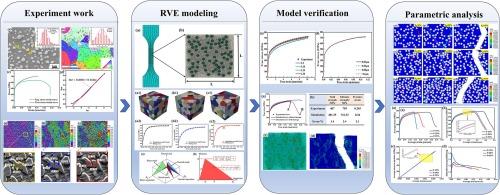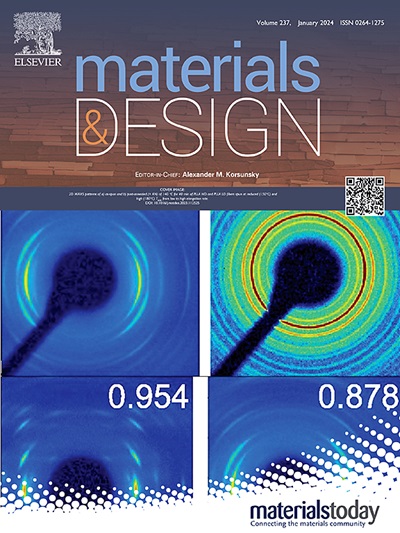Predictive mechanical property and fracture behavior in high-carbon steel containing high-density carbides via artificial RVE modeling
IF 7.6
2区 材料科学
Q1 MATERIALS SCIENCE, MULTIDISCIPLINARY
引用次数: 0
Abstract
The mechanical properties and fracture behavior of high-carbon steel are closely related to the microstructural characteristics. This work developed the artificial representative volume element (RVE) model to explore the effects of microstructural characteristics on mechanical properties and fracture behavior of high-carbon steel containing high-density carbides under uniaxial tension. A series of RVEs with different ferrite grain sizes, particle volume fractions, and particle sizes were generated based on the RSA algorithms. The mechanism-based plasticity model and the three uncoupled damage models were implemented into the RVE modeling. The model parameters were calibrated by the corresponding simulation between in-situ DIC and microstructure-based RVE simulation. The predicted mechanical properties and fracture strain from the RVE simulation were in good agreement with the experimental results. Simulated results from a series of RVEs quantified the effects of ferrite grain sizes, particle volume fractions, and particle sizes on strength, elongation, and damage evolution of high-carbon steel containing high-density carbides: strength increases with increasing particle volume fraction while elongation decreases, as well as excessively large or small grain and particle size were not favored to improve elongation. These results were attributed to the damage and internal stress partition.

通过人工 RVE 建模预测含有高密度碳化物的高碳钢的机械性能和断裂行为
高碳钢的力学性能和断裂行为与微观结构特征密切相关。本研究建立了人工代表体积元素(RVE)模型,以探讨微观结构特征对含有高密度碳化物的高碳钢在单轴拉伸下的力学性能和断裂行为的影响。根据 RSA 算法生成了一系列具有不同铁素体晶粒尺寸、颗粒体积分数和颗粒尺寸的 RVE。基于机理的塑性模型和三种非耦合损伤模型被应用到了 RVE 建模中。通过原位 μ DIC 和基于微观结构的 RVE 模拟之间的相应模拟,对模型参数进行了校准。RVE 模拟预测的力学性能和断裂应变与实验结果十分吻合。一系列 RVE 模拟结果量化了铁素体晶粒大小、颗粒体积分数和颗粒尺寸对含有高密度碳化物的高碳钢的强度、伸长率和损伤演化的影响:强度随颗粒体积分数的增加而增加,而伸长率则随之降低,过大或过小的晶粒和颗粒尺寸不利于提高伸长率。这些结果归因于损伤和内应力分区。
本文章由计算机程序翻译,如有差异,请以英文原文为准。
求助全文
约1分钟内获得全文
求助全文
来源期刊

Materials & Design
Engineering-Mechanical Engineering
CiteScore
14.30
自引率
7.10%
发文量
1028
审稿时长
85 days
期刊介绍:
Materials and Design is a multi-disciplinary journal that publishes original research reports, review articles, and express communications. The journal focuses on studying the structure and properties of inorganic and organic materials, advancements in synthesis, processing, characterization, and testing, the design of materials and engineering systems, and their applications in technology. It aims to bring together various aspects of materials science, engineering, physics, and chemistry.
The journal explores themes ranging from materials to design and aims to reveal the connections between natural and artificial materials, as well as experiment and modeling. Manuscripts submitted to Materials and Design should contain elements of discovery and surprise, as they often contribute new insights into the architecture and function of matter.
 求助内容:
求助内容: 应助结果提醒方式:
应助结果提醒方式:


